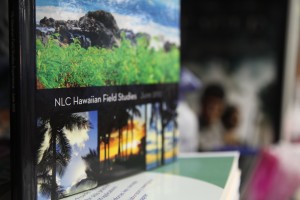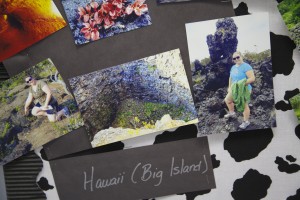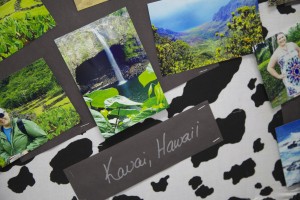By Erica Rohde
Staff Writer
A five by five inch photograph of a towering volcano, a lush rainforest canopy or a river eroding the surrounding rock printed in a textbook is the result of someone else’s memory.
The photographer captures the land as it breathes, the scientist records his observations and the schoolteacher knows that all of this information, when compiled into one resource, still does not match what is the greatest teacher of all; experience.
Before enrolling in the North Lake College Hawaiian Field Studies program back in 1999, current North Lake College Biology instructor Matt Dempsey was not expecting any change of route within his college career. He was set on medical school, and in the pursuit of an experience to put in his resume, he signed onto the Hawaiian Field Studies Program.

“I wanted something different, something to make me stand out,” Dempsey said. “When I went on this trip I realized what I wanted to do. It was sort of an awakening.”
Through the minds of his professors and the Hawaiian natives, their passion for the wildlife helped him see the inexhaustible opportunities for discovery and intuition in the beautiful place. Dempsey came back from the excursion shocked by his change in mind about his future, and ready to share his newfound love for biology.
Now in 2013 with a Master’s degree in Botany, Dempsey is leading the program June 17-30 and will be teaching the biology courses.
As a teacher, every day is a chance to inspire and motivate his students, but with this program, Dempsey believes that this program brings science up close and personal, ignites theories and makes students really want to learn.
“When you open up a textbook there is a two-dimensional explanation of a concept or an organism,” Dempsey said. “The type of learning that goes on when you can engage all of your senses is a richer learning environment. It’s a complete experience and it makes learning fun and easy.”
The Hawaiian Field Studies program is a way to earn 16 credit hours; classes in Botany, Environmental Biology, Earth Science, Digital Photography and even a P.E. course, all wrapped up into one trip. Costs would round up to about $3,500 excluding luggage and food costs for the trip all together.
Dempsey wants students to see this not only as an opportunity to gain credits, but he wants the students to study nature in Hawaii for good reason.
 “The ecosystems are so varied and so easily accessible that you can study animal and plant diversity in a tight space,” Dempsey said. “They are going to see what they see and enjoy what they enjoy. But what I want for them is to understand the struggle for life on earth and to gain an appreciation for that struggle and become part of the solution. I have to teach what I have to teach, but there is a bigger story. Looking at the Hawaiian Islands is like looking at a microcosm of the struggle of life on earth. In Hawaii you can be standing in a rainforest looking at snow and turn around and look at a desert.”
“The ecosystems are so varied and so easily accessible that you can study animal and plant diversity in a tight space,” Dempsey said. “They are going to see what they see and enjoy what they enjoy. But what I want for them is to understand the struggle for life on earth and to gain an appreciation for that struggle and become part of the solution. I have to teach what I have to teach, but there is a bigger story. Looking at the Hawaiian Islands is like looking at a microcosm of the struggle of life on earth. In Hawaii you can be standing in a rainforest looking at snow and turn around and look at a desert.”
Dempsey knew how the trip could affect students’ outlook on science, and reached out to Coppell High School science classes to get more students involved.
“Matt Dempsey had contacted me about coming to my class and talking about the Hawaiian Field studies program,” CHS aquatic science teacher Laronna Doggett said. “So over the years we have formed a friendship.”
Dempsey had visited Doggett’s classes teaching on the topic of Aquatic Plants. Students became intrigued not only by his knowledge on the subject, but his true love and enthusiasm for learning.
One of the students who attended last year’s trip, senior Anton Paroski was one of a few who wanted to explore more of what he had to offer.
“His presentations at our high school really caught my eye,” Paroski said. “It looked awesome, and it looked very challenging.”
In deciding to go, Paroski took the required pre-trip classes on the weekends during the school year.
“We learned about why we were going to Hawaii,” Paroski said. “It is isolated in the largest ocean in the world, and because of that, the plants and animals are unique. Our classroom was going to be the outdoors. It was brilliant.”
The pre-classes were the only part of the program where the students were in a set classroom, otherwise students brought around materials to take notes with. They brought back such memories of studying and learning about new concepts, star gazing, viewing lava, hiking into pristine rainforest, collecting organisms on the beach, hiking to a waterfall, various tours, snorkeling, kayaking and luaus.
“My favorite part would probably be arriving on the island of Kauai,” Paroski said. “The soil was the oldest there so it had a lot of time to erode. It is the greenest of all of the islands and it is very beautiful. We also learned that it is fed by the rainiest spot in the world; Waiʻaleʻale.”
As far as the curriculum and testing goes, Doggett thinks it is a breeze because of how much students participate and become invested in the environment around them.
“A lot of the points come from participation in the labs, going and looking at the different plants, looking at their adaptations,” Doggett said. “There is a journal that you keep, but you have to try really hard to fail. There are safeguards put in there.”
But students see more than the science involved. They see the culture around them, the humility and love of the natives for their land and animals.
“You are working with people who are native to Hawaii, they love their state, they love their heritage, they are very proud of what they have,” Doggett said. “We went to this one facility that studies birds. They talked about how the birds are being decimated because of the Mongoose that was introduced as an invasive species. You cannot replication that passion that they had for what they do, that true love of nature. The guide that we had, you cannot replicate that passion. At the very end he sang this song about his land and his heritage.”
Everyone involved with the program agrees that the program is an enriching and rewarding experience, and is open to all ages, students of the college or none students of the college. This year’s sign up list is expecting to be between 15 to 20 participants, and the program is still open to a few more.
“We have had anywhere from a 16-year-old to a 40-year-old,” Doggett said. “The 40 year old was a lawyer and wanted to go back and do something different. You meet fascinating people, lifelong friends. It enriches your life.”








